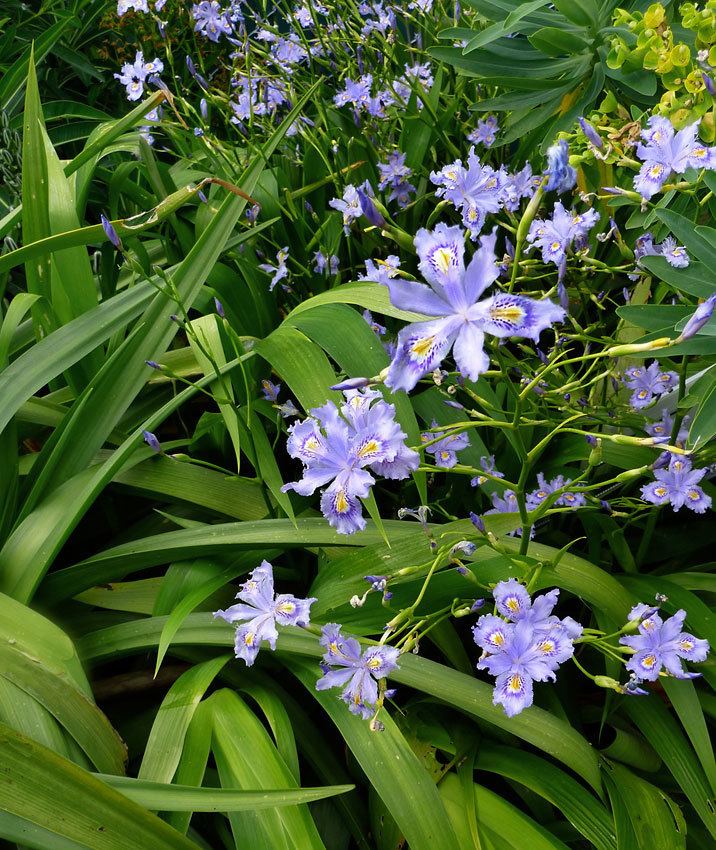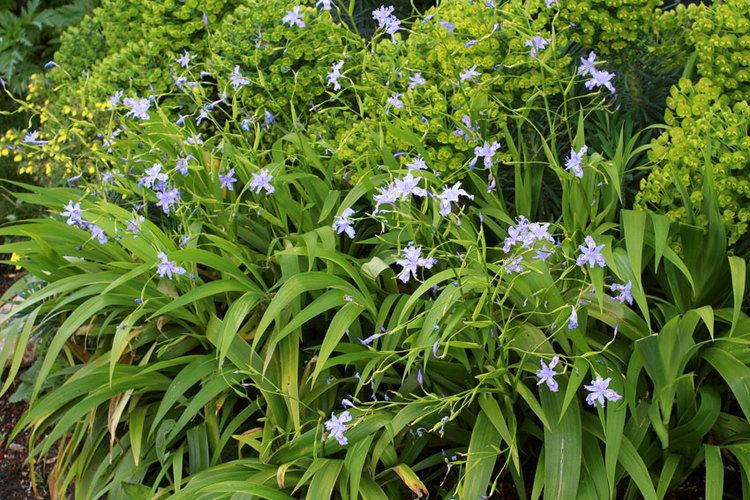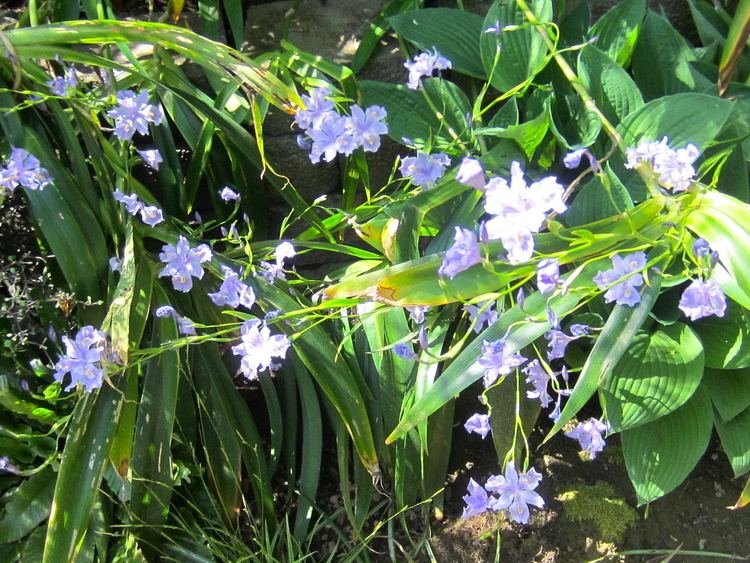Rank Species | Section Lophiris Higher classification Irises | |
 | ||
Similar Irises, Iridaceae, Iris wattii, Iris japonica, Iris tectorum | ||
Iris confusa (also known as the Bamboo iris (simplified Chinese: 扁竹兰; traditional Chinese: 扁竹蘭; pinyin: Biǎn zhú lán) is a species of iris, it is also in the subgenus of Limniris and in the Lophiris section (crested irises). It is a rhizomatous perennial plant, native to Western China. It has flowers which range from white to a soft lavender or pale blue in colour, with orange-yellow crests and purple dots. The plant's broad, shiny leaves are attached to bamboo-like stems. It is cultivated as an ornamental plant in temperate regions.
Contents
- Description
- Biochemistry
- Taxonomy
- Distribution and habitat
- Range
- Habitat
- Cultivation
- Propagation
- Hybrids and Cultivars
- Toxicity
- Uses
- References

Description

It is similar in form to Iris japonica and Iris wattii. Iris confusa is larger than Iris japonica in all parts. Also the foliage of Iris japonica, has less attractive foliage then Iris confusa. Compared to Iris wattii, it is smaller and has smaller flowers.

It has stout, creeping rhizomes. They are short and bamboo-like. It also has short stolons. On top of the rhizome are various scars and the remains of last seasons leaves. The creeping habit eventually forms thick clumps.
It has 10 or more leaves that are grouped together as a fan-shape.

Unlike, most irises, the foliage is held on top of the bamboo-like stems. So it more looks like a palm. The sword-shaped, or strap-shaped, leaves are yellowish-green, to bright green, glossy (or shiny) on one side, and glaucous on the other side. They are lighter in colour than Iris japonica, and are normally thought to be evergreen. The leaves can grow up to between 28–80 cm (11–31 in) tall and 3–6 cm (1–2 in) wide. They veins can not be seen, and the leaves ten to flop over.
It has flattened, (bamboo) cane-like stems, that can grow up to between 25–120 cm (10–47 in) tall. It has 5-8 slender branches (or pedicels) near top of the plant. The stiff pedicels are 1.5–2 cm long. The stems can lie along the ground (after flowering) and can eventually produce roots, creating larger clumps of plants.
The stems have 4-6 spathes (leaves of the flower bud), which are generally membranous. They are 1.5 cm wide.
The stems (and the many branches) hold between 3 and 5 flowers, in spring and early summer, between April and May. It can flower in early spring, if the plant is protected from the frost, in the UK. The flowers are short lived, but since, the plant has many flowers, up to 75 flowers, a continuous display can last for several weeks.
The flowers are 4–5.5 cm (2–2 in) in diameter, and come in shades of soft lavender, to pale blue, to white.
It has 2 pairs of petals, 3 large sepals (outer petals), known as the 'falls' and 3 inner, smaller petals (or tepals, known as the 'standards'. The falls are elliptical, have a rounded top (retuse), and have wide limb (section of the petal, closest to the stem), they are 2–3 cm (1–1 in) cm long and 1.5–2 cm wide. On the blade is a yellow or yellow-orange ridge (or crest). Surrounding the crest/ridge are orange-yellow, or pale mauve, or purple spots. The standards are broadly lanceolate and have a rounded top (retuse). They are 2.5 cm long and 1 cm wide. Both petals have wavy or scalloped edges.
It has pale blue style branches which have fringed lobes, and are 2 cm long and 8mm wide.
It has a 1.5 cm long perianth tube, 1.5 cm long stamens, 6mm long ovary and yellow anthers.
After the iris has flowered, it produces an ellipsoid seed capsule, between May and July. It is 2.5–3.5 cm (1–1 in) cm long and 1-1.4 cm wide and has 6 visible ribs. Inside the capsule, are D-shaped, dark brown seeds.
Biochemistry
In 1992, a study was carried out on the cells of Iris confusa, to check if there was any deviation in the chromosomal count of the iris.
In 1998, a study was carried out on germination of the seeds of Iris confusa and inhibitory affects stopping or slowing the germination.
In 2003, a study was carried out on the cells and chromosomes of Iris japonica and Iris confusa. It found out they are very closely related.
In 2009, a study was carried out on ten Iris species from China. Including Iris confusa, Iris japonica and Iris wattii. It was found that there was a similarity between Iris japonica and Iris wattii, but not with Iris confusa.
As most irises are diploid, having two sets of chromosomes, this can be used to identify hybrids and classification of groupings. It has been counted several times, (Simonet 1934), (Snoad 1952), and (Chimphamba, 1973). It is 2n=30.
Taxonomy
It is pronounced as (Iris) EYE-ris (confusa) kon-FEW-suh.
It has the common name of 'Bamboo Iris'.
It is written as 扁竹兰 in Chinese script, and known as bian zhu lan in Pidgin in China. Bian zhu lan is translated into English as 'flat bamboo-orchid'.
The Latin specific epithet confusa refers to confusus from - uncertin, easily mistake and mingle.
In 1911, William Rickatson Dykes obtained seeds from Pere Ducloux, a French missionary, (1864-1945), who had found specimens of the iris in the Yunnan. Dykes later compared the plants (he grew) in 1915, with specimens in the Kew Gardens Herbarium, and thought they were similar to Iris wattii, so were a form of Iris wattii.
Between 1924 and 1926, Dr. Stapf of Kew, re-examined the specimens and concluded that they were more similar to Iris japonica. He died in 1933, without publishing his findings.
In 1931, Major Lawrence Johnson found a specimen near Tengyeh, in Yunnan. It was looked at by Kew and realised to be a specimen of Iris wattii.
It was first published and described by Joseph Robert Sealy in Gardener' Chronicle Series III, issue102 page 434 in 1937.
It was verified by United States Department of Agriculture and the Agricultural Research Service on 4 April 2003 and then updated on 2 December 2004.
Iris confusa is an accepted name by the RHS.
Distribution and habitat
It is native to temperate regions of Asia.
Range
It is found in China, within the Chinese provinces, of Guangxi, Guizhou, Sichuan, and Yunnan.
Habitat
It grows beside forests (and woods), in open groves, on hillside grasslands (and meadows), and in ditches. It can also be found growing on in the midst of rocks and scrub on sharp or steep slopes.
They can be found at an altitude of 1,600–2,400 metres (5,200–7,900 ft) above sea level.
Cultivation
It is hardy to between USDA Zone 9 – Zone 11. It is thought hardy to -5C, it can be left outdoors in warm parts of the USA, such as California. It is also hardy to European Zone H4. In Britain (and some parts of Europe), it is classed as Tender, so can be grown in a pot and then over-winter in a cool greenhouse. In Australia, it can be grown beneath shrubs (as frost protection.
It can be grown in well-drained, light rich (containing humus) soils. It can tolerate neutral or acidic soils (PH levels between 6.5 – 7.8). It slightly prefers acidic soils (including peat banks).
It can tolerate positions between full sun and partial shade.
It does prefer sites out of strong winds, due to the height of the plant and delicate flowers.
It has average water needs during the growing season. But wet or damp conditions during the winter may cause the root to rot.
It can be grown in a mixed flower border. Due to its shallow roots, the iris prefers a mulch of peat, well decayed leaf mould or similar. The mulch also helps with the frost protection as well.
It can be also grown in containers, in sheltered positions. Such as a 30–35 cm wide pot, which is well drained and filled with ericaceous soils.
It can be affected by slugs and snails.
The stems and dead leaves should be removed after flowering to keep the plant tidy and help it, for next years growth. The stems should be removed to ground level.
It is found in specialised iris nurseries.
It can be seen growing within the temperate house at Kew.
Propagation
It can also be propagated by division or by seed growing.
The division of the rhizomes should done after flowering, between September and November.
It also can be propagated by stem cuttings. If the cuttings are immersed in water for between 1–2 weeks. The roots will soon emerge and the new plant can be potted, and prepared for the garden later. Better results are gained if the water, contains lumps of charcoal.
To propagate from seed, collect seed from the capsules, when ripe and sow the seeds in vented containers, within a cold frame or in unheated greenhouse.
Hybrids and Cultivars
It has several named cultivars.
Including;
Toxicity
Like many other irises, most parts of the plant are poisonous (rhizome and leaves), if mistakenly ingested can cause stomach pains and vomiting. Also handling the plant may cause a skin irritation or an allergic reaction.
Uses
It is used within Yunnan as an ingredient in Chinese herbal medicines.
Within the province of Guangxi, the Kam people of 'Gaoxiu Village', use the leaves (of the iris) for healing broken bones and sprains. The leaves are macerated and applied as a poultice, with a splint for supporting and immobilizing the affected area of the body. Plant healer, 'Yang Chang Jun' believes that Iris confusa is among the most valued medicinal plants for treating fractures and sprains. The Kam people, also eat fish that are fed fresh Iris tectorum, as a medicine to treat stomach aches
A patent in China, was made for Iris confusa health-care tea, (made from the blue flowers of the iris), which is thought to help patients with acute tonsillitis, acute laryngopharyngitis, acute bronchitis, nephritis edema and urinary tract infections.
